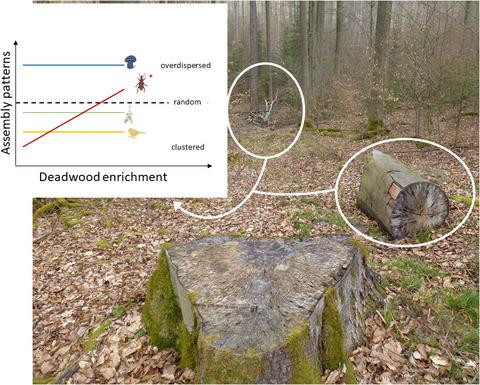当前位置:
X-MOL 学术
›
J. Appl. Ecol.
›
论文详情
Our official English website, www.x-mol.net, welcomes your feedback! (Note: you will need to create a separate account there.)
Restoration‐oriented forest management affects community assembly patterns of deadwood‐dependent organisms
Journal of Applied Ecology ( IF 5.7 ) Pub Date : 2020-08-11 , DOI: 10.1111/1365-2664.13741 Inken Doerfler 1, 2 , Marc W. Cadotte 3 , Wolfgang W. Weisser 1 , Jörg Müller 4, 5 , Martin M. Gossner 6 , Christoph Heibl 5 , Claus Bässler 5, 7 , Simon Thorn 4 , Sebastian Seibold 8, 9
中文翻译:

以恢复为导向的森林管理影响依赖枯木的生物的社区聚集模式
更新日期:2020-08-11
Journal of Applied Ecology ( IF 5.7 ) Pub Date : 2020-08-11 , DOI: 10.1111/1365-2664.13741 Inken Doerfler 1, 2 , Marc W. Cadotte 3 , Wolfgang W. Weisser 1 , Jörg Müller 4, 5 , Martin M. Gossner 6 , Christoph Heibl 5 , Claus Bässler 5, 7 , Simon Thorn 4 , Sebastian Seibold 8, 9
Affiliation

|
- Land‐use intensification leads to loss and degradation of habitats and is thus a major driver of biodiversity loss. Restoration strategies typically focus on promoting biodiversity but often neglect that land‐use intensification could have changed the underlying mechanisms of community assembly. Since assembly mechanisms determine the diversity and composition of communities, we propose that evaluation of restoration strategies should consider effects of restoration on biodiversity and community assembly. Using a multi‐taxon approach, we tested whether a strategy that promotes forest biodiversity by restoring deadwood habitats also affects assembly patterns.
- We assessed saproxylic (i.e. deadwood‐dependent) beetles and fungi, as well as non‐saproxylic plants and birds in 68 beech forest plots in southern Germany, 8 years after the commencement of a restoration project. To assess changes in community assembly, we analysed the patterns of functional–phylogenetic diversity, community‐weighted mean (CWM) traits and their diversity. We hypothesized that restoration increases habitat amount and heterogeneity of deadwood and reduces canopy cover and thereby decreases the strength of environmental filters imposed by past silvicultural intensification, such as a low amount in deadwood.
- With the restoration of deadwood habitats, saproxylic beetle communities became less functionally–phylogenetically similar, whereas the assembly patterns of saproxylic fungi and non‐saproxylic taxa remained unaffected by deadwood restoration. Among the traits analysed, deadwood diameter niche position of species was most strongly affected indicating that the enrichment of large deadwood objects led to lower functional–phylogenetical similarity of saproxylic beetles. Community assembly and traits of plants were mainly influenced by microclimate associated with changes in canopy cover.
- Synthesis and applications. Our results indicate that the positive effects of deadwood restoration on saproxylic beetle richness are associated with an increase in deadwood amount. This might be linked to an increase in deadwood heterogeneity, and therefore decreasing management‐induced environmental filters. Deadwood enrichment can thus be considered an effective restoration strategy which reduces the negative effects of intense forest management on saproxylic taxa by not only promoting biodiversity but also by decreasing the environmental filters shaping saproxylic beetle communities, thus allowing the possibly for more interactions between species and a higher functional diversity.
中文翻译:

以恢复为导向的森林管理影响依赖枯木的生物的社区聚集模式
- 土地利用的集约化导致栖息地的丧失和退化,因此是生物多样性丧失的主要驱动力。恢复策略通常侧重于促进生物多样性,但往往忽略了土地利用集约化可能改变了社区集会的基本机制。由于集会机制决定了社区的多样性和组成,因此我们建议对恢复策略的评估应考虑恢复对生物多样性和社区集会的影响。我们使用多类分类方法,测试了通过恢复枯木栖息地来促进森林生物多样性的策略是否也会影响组装模式。
- 在恢复项目开始八年后,我们评估了德国南部68个山毛榉林地中的鼠尾草(即依赖枯木的甲虫)和真菌以及非鼠尾草的植物和鸟类。为了评估社区集会的变化,我们分析了功能系统发育多样性,社区加权均值(CWM)特征及其多样性的模式。我们假设,恢复会增加枯木的栖息地数量和异质性,并减少冠层的覆盖,从而降低过去的森林栽培集约化所带来的环境过滤器的强度,例如少量的枯木。
- 随着枯木栖息地的恢复,红木甲虫群落的功能-系统发育上的相似性降低,而红木真菌和非红木类群的组装方式仍不受硬木恢复的影响。在所分析的特征中,物种的枯木直径生态位位置受到的影响最大,这表明大型沉木物体的富集会导致较低的Saproxylic甲虫的系统发育相似性。植物群落的组成和性状主要受与盖层变化有关的小气候的影响。
- 综合与应用。我们的研究结果表明,沉木恢复对saproxylic甲虫丰富度的积极影响与沉木量的增加有关。这可能与沉材异质性的增加有关,从而减少了管理引起的环境过滤器。因此,沉木富集可以被认为是一种有效的恢复策略,它不仅可以通过促进生物多样性,而且可以通过减少环境过滤器来塑造Saproxy甲虫群落,从而减少密集的森林经营对Saproxylic甲虫的负面影响,从而可能在物种和植物之间产生更多的相互作用。更高的功能多样性。



























 京公网安备 11010802027423号
京公网安备 11010802027423号